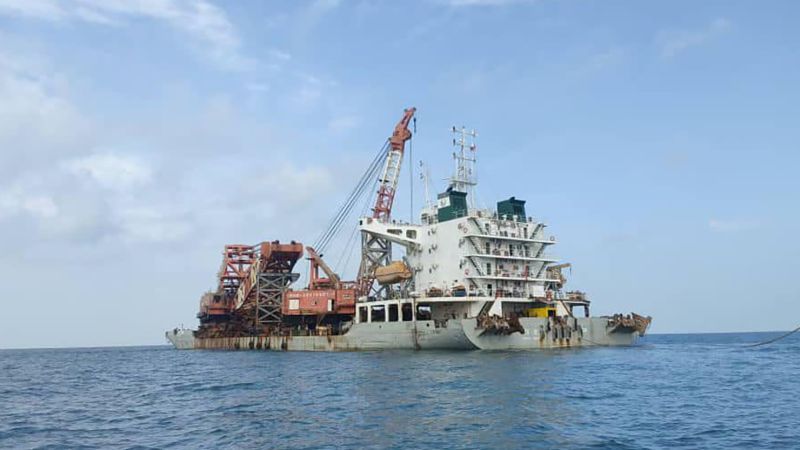Malaysia investigating possible looting of World War II British shipwrecks
CNN —
Malaysian authorities have detained a Chinese-flagged cargo ship amid reports of the salvaging of World War II shipwrecks in Malaysia’s exclusive economic zone, according to a report from the state-run Bernama news agency.
The ship was detained and boarded after it was found not to have authorization to anchor in the waters under Malaysian jurisdiction, according to the Bernama report, which cited the Malaysian Maritime Enforcement Agency.
An inspection of the ship “led to the discovery of old steel and cannon shells,” the report said.
Police, the Malaysian Marine Department and the National Heritage Department would investigate to see if the shells are from World War II, according to the report.
It noted that media outlets around the region have recently reported that “a foreign salvage ship was conducting an illegal operation to salvage steel from a British warship that sank” in the area.
The case was being investigated under Malaysia’s Merchant Shipping Ordinance, which covers underwater operations among other activities, according to Bernama.
The area is the site of the wrecks of two British warships, the battleship HMS Prince of Wales and cruiser HMS Repulse, sunk in an attack by Japanese warplanes on December 10, 1941, just two days after Japan attacked the US naval base at Pearl Harbor, Hawaii.
Authorities are investigating whether shells found on the ship are from World War II, Malaysian state media said. Malaysian Maritime Enforcement Agency/Facebook
The attack by dozens of Japanese aircraft armed with bombs and torpedoes left 842 men dead. The wrecks are classified as war graves under British law.
Reports of the alleged salvaging of the wrecks brought condemnation in Britain.
“We are distressed and concerned at the apparent vandalism for personal profit of HMS Prince of Wales and HMS Repulse,” said professor Dominic Tweddle, director general of the National Museum of the Royal Navy, in a statement.
“They are designated war graves. We are upset at the loss of naval heritage and the impact this has on the understanding of our Royal Navy history,”
John Bradford, senior fellow at the S. Rajaratman School of International Studies in Singapore said marine salvage “is an emotional business.”
“To many people, this feels more like robbing the graves of national heroes rather than reclaiming scrap,” he said.
Murky law
Salvaging of sunken World War II wrecks around the Pacific is not a new problem.
In 2017, Dutch, British and US authorities reported that naval vessels sunk in the World War II Battle of the Java Sea had been salvaged without permission.
All traces of two Dutch cruisers and two British ships had disappeared, according to reports from 2017.
Steel from World War II shipwrecks can have special value because it is was produced before the first nuclear explosions on Earth. Known as “low-background steel,” it is needed for some special scientific instruments because it contains no traces of nuclear fallout.
But Bradford said there may be other reasons behind the alleged looting of the Prince of Wales and the Repulse.
“The fact that intact gun shells were recovered by the Malaysian authorities suggests the salvagers are not just seeking scrap metal but may be looking for trophies with high resale value,” he said.
International law on the salvage of sunken warships is murky, according to a 2017 report from the Peace Palace Library at the Hague in the Netherlands.
“The legal regime appertaining to the wrecks of warships and State-owned ships remained complex, fractured, and in serious need of clarification,” the report said.
Blake Herzinger, a research fellow from the United States Studies Centre at the University of Sydney, said registering nations must be the ones to stop salvaging of wrecks that are war graves.
“Ultimately, the flag state is responsible for ensuring that vessels carrying its flag do not engage in illegal conduct. And if there is such a pattern of behavior, it is down to the flag state to take action,” he said.
HMS Prince of Wales and HMS Repulse, operating out of Singapore, sank after coming under a fierce attack from land-based Japanese warplanes while attempting to confront a Japanese amphibious landing on the Malaysian coast.
Their sinking is considered one of the worst naval disasters in the history of the Royal Navy.
It was also one of the first battles to show that even the most powerful of modern warships – the Prince of Wales was only commissioned less than a year before it sank – were vulnerable without supporting air power.
The Japanese planes attacked the British ships from airstrips around the region, while there was no British air cover for the two surface ships, after an aircraft carrier that was supposed to accompany them in what was called “Force Z” had run aground during its voyage to the Pacific.
Source: CNN


